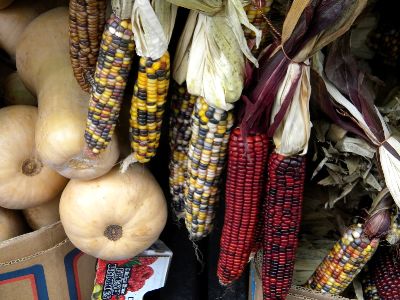
A less limited diet for the feasters has been speculated on by historians, though. For instance, the diners may have also enjoyed nuts, fish, lobsters, clams, pumpkins, squash, peas, and carrots.
After a difficult Mayflower voyage from England, Plimoth was begun very late in 1620 by 102 colonists (after one boy had died on the journey but another had been born during the crossing), many of whom were Puritans, pilgrims who sought to keep their religion pure and separate from the Church of England. Whether they were in fact fleeing religious persecution or seeking a place where they could practice their preferred form of religious discrimination, unfettered by the conventions of the mother country, is still debated.
By October, 1621, the small group of colonists had endured a harrowing first several months. Their charter and intended destination was for Virginia. Whether due to complications of the voyage or to a conspiracy, they had instead arrived in November, 1620, in the Cape Cod harbor area. Following fresh adventures, explorations, and an unfortunate early encounter with Native Americans, their landing where the Plimoth Colony would be built did not occur until December 21.
Winter in Plymouth, MA, then or now, is not mild. For their first full month on land in the New World, the high temperatures were likely in the mid-thirties and the lows, in the mid-teens (F). Significantly warmer temperatures would probably not have occurred until April or May. Indians befriended them and taught those who made it through their first months in New England how to trap beaver, fish, and plant. Till then, their originally meager stores were supplemented by theft from other Indians' food cashes, amounting however to but a few bushels of corn and beans. The two dogs, a mastiff and a spaniel, which arrived at Plimoth with the human colonists may have provided a bit of added sustenance too during that harsh introductory season. The ship's captain insisted he had brought food only for his crew's return trip and could spare none for the colonists.
Women and children at first slept onboard the Mayflower, for the vessel did not return to England till spring. Though the men built themselves a common house onshore, it completely burned shortly after being finished. A major epidemic decimated the colonists' ranks. At times less than 5% of them were well enough to tend to the needs of those who were ill. In the end, only about 40% of the men and boys survived the first year in America.
Under the circumstances, it is perhaps not remarkable that, when there was a providentially good harvest by October, 1621, it was deemed a fine time to give thanks. Till then, "Thanksgiving" among Europeans had meant a time of fasting.
The recognition (by President Abraham Lincoln) of this as a national holiday to be repeated annually would not come for another 241 years. President Franklin Roosevelt established its date as we celebrate it now, each fourth Thursday in November.
And year after year we have, indeed, fantastic boons for which to be grateful. The average life expectancy in our country, for example, is more than twice what it was in 1621. Apart from that, our buying power as individuals and our supplies of easily available vittles have expanded vastly in the intervening years.
These days, folks may celebrate the holiday by focusing on family, by doing volunteer work for people who are especially in need, by making contributions of food, clothes, funds, or different material gifts to others less well off than they, by going on interesting or fun trips together, by spending extra hours in more natural settings, by going fishing or hunting, by watching or participating in rodeos, by taking the time for meaningful workshops and retreats, by enjoying sporting, dramatic, choral, dance, or spiritual activities together, by having canning, barn raising, quilt-making, sing-along, or barbeque parties, and so on. In whatever ways one chooses to enjoy this year's Thanksgiving, we hope that on November 22, 2012, we take time to appreciate the many things we all have for which to be grateful, chief among them the joy of simply being, here and now, in this very moment, alive.
Primary Source: Thanksgiving 2011 Myths and Facts. Brian Handwerk in National Geographic News; November 22, 2011.